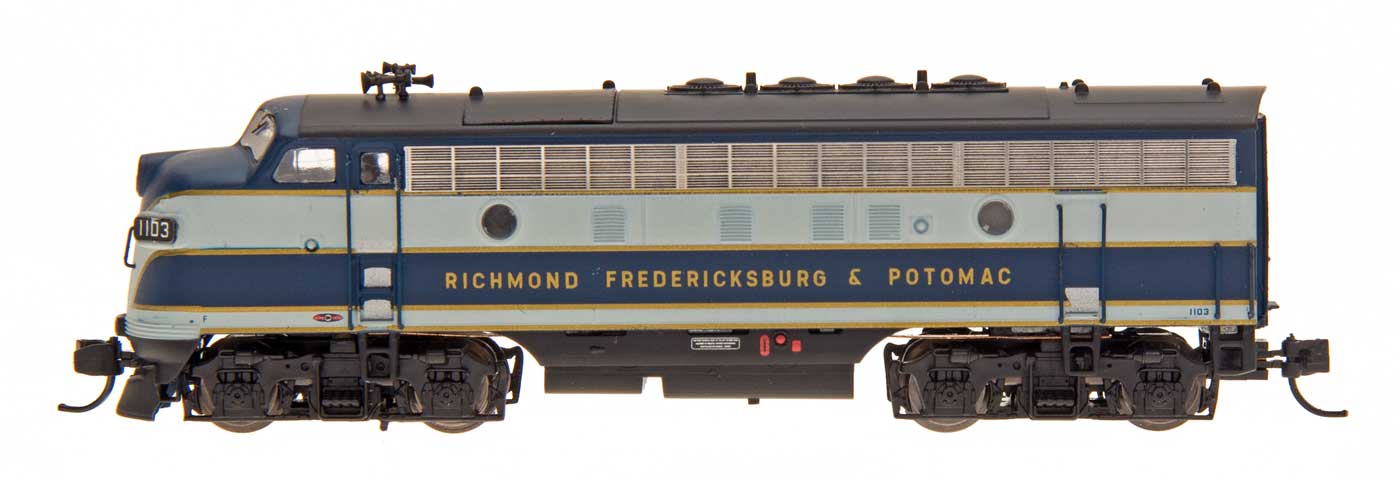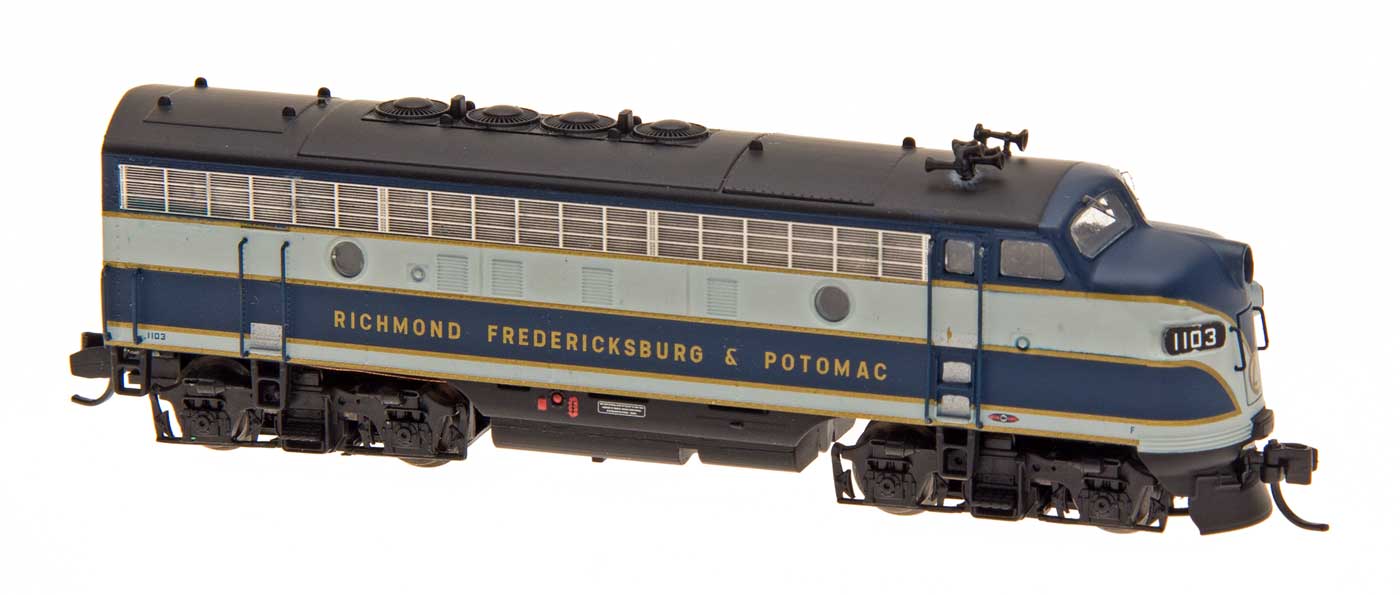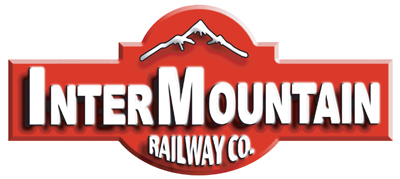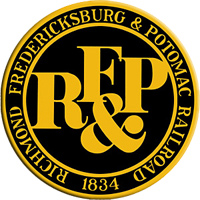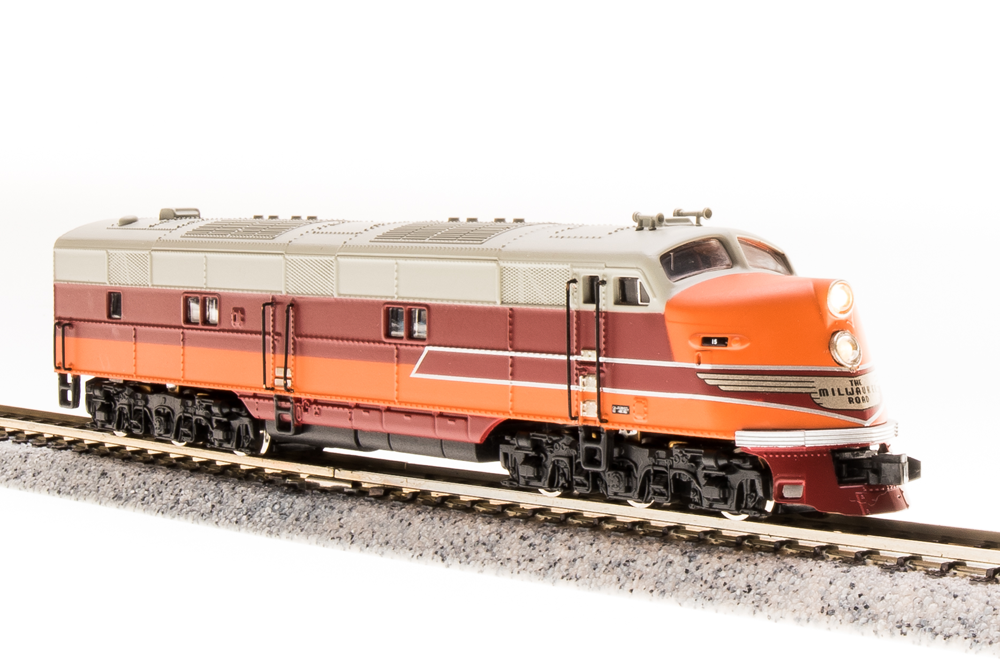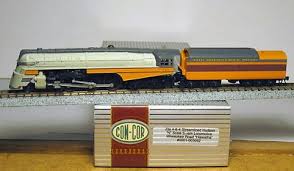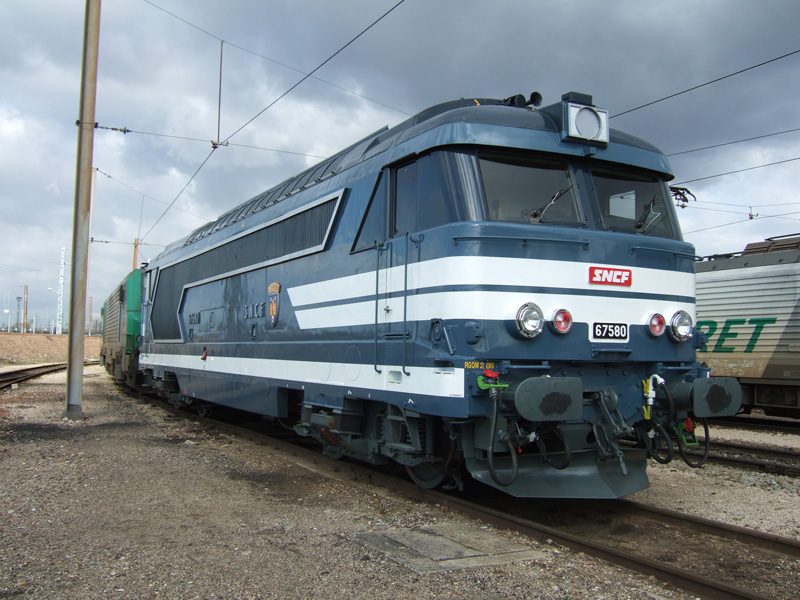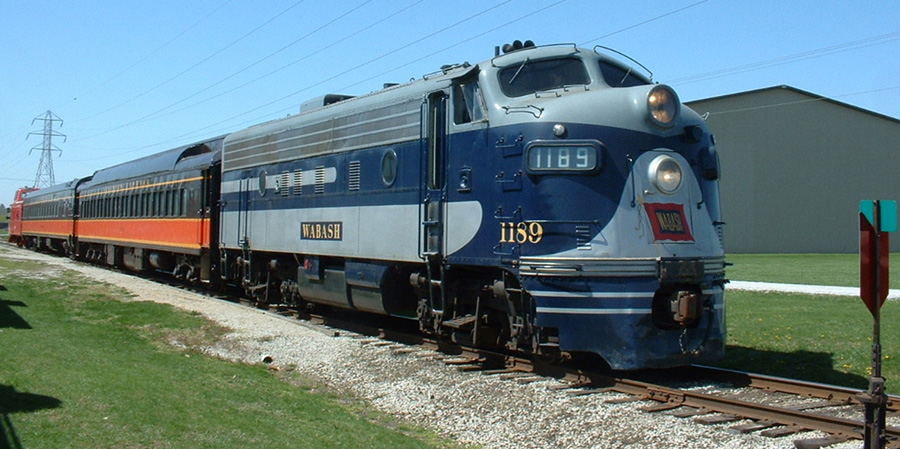InterMountain - 69255-01 - Locomotive, Diesel, EMD F7 - Richmond Fredericksburg & Potomac - 1102
| Stock Number | 69255-01 |
| Original Retail Price | $119.95 |
| Brand | InterMountain |
| Manufacturer | InterMountain Railway |
| Body Style | Intermountain Diesel F7 (A+B+FP7) |
| Image Provider's Website | Link |
| Prototype Vehicle | Locomotive, Diesel, EMD F7 (Details) |
| Road or Company Name | Richmond Fredericksburg & Potomac (Details) |
| Road or Reporting Number | 1102 |
| Paint Color(s) | Black, Light Blue, Dark Blue and Gold |
| Print Color(s) | Gold |
| Coupler Type | Intermountain Magnetic Knuckle |
| Coupler Mount | Body-Mount |
| Wheel Type | Chemically Blackened Metal |
| Wheel Profile | Small Flange (Low Profile) |
| DCC Readiness | Ready |
| Release Date | 2018-12-01 |
| Item Category | Locomotives |
| Model Type | Diesel |
| Model Subtype | EMD |
| Model Variety | F7A |
| Prototype Region | North America |
| Prototype Era | NA Era III: Transition (1939 - 1957) |
| Scale | 1/160 |
Model Information:
Features of this model include (2023 run):
Features of this model include (2023 run):
- LED lighting - All lights separately controllable on DCC units.
- Upper nose MARS Light (where applicable)(single headlight units, upper nose light acts as the headlight)
- Lower Headlight (where applicable)
- Illuminated number boards
- Ditch Lights (DCC only)(No units factory equipped with ditch lights, however LEDs are provided for use by the modeler)
- Wire & Etched metal details
- Laser sharp painting and printing
- Micro-Trains compatible couplers
DCC Information:
The 2023 run is available in 3 versions:
The 2023 run is available in 3 versions:
- DC models equipped with a DC only circuit board and are DCC Ready.
- Non-Sound equipped with an ESU LokPilot 5 DCC decoder (stock number suffixed by letter D)
- Sound units equipped with an ESU LokSound 5 sound decoder. Real F7 locomotive recordings used for superior accuracy and quality! (stock number suffixed by letter S)
Prototype History:
The F7 was the fourth model in GM-EMD's successful line of F unit locomotives, and by far the best-selling cab unit of all time. In fact, more F7's were built than all other F units combined. It succeeded the F3 model in GM-EMD's F unit sequence, and was replaced in turn by the F9. Final assembly was at GM-EMD's La Grange, Illinois, plant or GMD's London, Ontario, facility.
The F7 differed from the F3 primarily in internal equipment (mostly electrical) and some external features. Its continuous tractive effort rating was 20% higher (e.g. 40,000 lb (18,000 kg) for an F7 with 65 mph (105 km/h) gearing, compared to 32,500 lb (14,700 kg) for an F3 with the same gearing.
A total of 2,366 cab-equipped lead A units and 1,483 cabless-booster or B units were built. (Note: the B unit is often referred to as an "F7B", whereas the A unit is simply an "F7".)
Many F7s remained in service for decades, as railroads found them economical to operate and maintain. However, the locomotive was not very popular with yard crews who operated them in switching service because they were difficult to mount and dismount, and it was also nearly impossible for the engineer to see hand signals from a ground crew without leaning way outside the window. As most of these engines were bought and operated before two-way radio became standard on most American railroads, this was a major point of contention. In later years, with the advent of the "road switchers" such as the EMD GP7, F units were primarily used in "through freight" and "unit train" service where there was very little or no switching to be done on line of road.
From Wikipedia
Read more on American-Rails.com
The F7 differed from the F3 primarily in internal equipment (mostly electrical) and some external features. Its continuous tractive effort rating was 20% higher (e.g. 40,000 lb (18,000 kg) for an F7 with 65 mph (105 km/h) gearing, compared to 32,500 lb (14,700 kg) for an F3 with the same gearing.
A total of 2,366 cab-equipped lead A units and 1,483 cabless-booster or B units were built. (Note: the B unit is often referred to as an "F7B", whereas the A unit is simply an "F7".)
Many F7s remained in service for decades, as railroads found them economical to operate and maintain. However, the locomotive was not very popular with yard crews who operated them in switching service because they were difficult to mount and dismount, and it was also nearly impossible for the engineer to see hand signals from a ground crew without leaning way outside the window. As most of these engines were bought and operated before two-way radio became standard on most American railroads, this was a major point of contention. In later years, with the advent of the "road switchers" such as the EMD GP7, F units were primarily used in "through freight" and "unit train" service where there was very little or no switching to be done on line of road.
From Wikipedia
Read more on American-Rails.com
Road Name History:
The RF&P ran from Richmond, Virginia north 114 miles to Potomac Yard (known widely as Pot Yard) on the river near Washington D.C. The purpose of the line was to link the Pennsylvania Railroad and Baltimore & Ohio lines to the northeast with the Seaboard Air Line and Atlantic Coast Line lines to the south. There were few branchlines of consequence and the mainline was entirely double tracked with no grades to speak of. It was operated as a single route as early as 1901 although the route north of Quantico actually belonged to a PRR subsidiary called the Washington Southern. RF&P absorbed the Washington Southern in 1920. There were also connections with Southern and C&O but C&O traffic in the area was almost entirely east-west and Southern had their own line to Washington D.C.
Traffic was heavy and fast. Pacifics were used for freight and passenger service. These were supplanted by 4-8-2 Mountains then by Northerns and Berkshires. Aside from some Alco switchers, RF&P was an entirely EMD road in the diesel era. E8’s and FP7’s hauled the passengers (mostly PRR, SAL and ACL trains) while F5’s and F7’s hauled freight with GP7’s in support. The second generation brought GP35’s, and GP40’s for road service. The diesel fleet usually ran just under 40 units for the 114 mile line (indicating very heavy traffic.) As a rule, even numbered units faced north and odd numbered units faced south. Road switchers were equipped with dual cab controls and running long hood forward was common.
By 1987, RF&P’s situation had changed. The former PRR connection had mostly faded as Amtrak operated the line to the northeast and not Conrail. That left the former B&O on the north end and the former Seaboard System on the south end. Both were now part of CSX. RF&P was still a vital link but it didn’t make sense to be a separate railroad. CSX already owned much of the stock but a quarter of the shares of RF&P were owned by the state of Virginia’s state employee retirement fund. In the end, CSX gave the state fund the property rights to Potomac Yard in exchange for all of the stock. Pot Yard originated or terminated very little traffic with nearly every train just running through so the property was ripe for development. In fact there was talk of turning part of the property into a new stadium for the Washington Redskins. In the end, it became commercial property instead. The state was happy and CSX closed the gap on their system map. RF&P merged into CSX in 1991.
Traffic was heavy and fast. Pacifics were used for freight and passenger service. These were supplanted by 4-8-2 Mountains then by Northerns and Berkshires. Aside from some Alco switchers, RF&P was an entirely EMD road in the diesel era. E8’s and FP7’s hauled the passengers (mostly PRR, SAL and ACL trains) while F5’s and F7’s hauled freight with GP7’s in support. The second generation brought GP35’s, and GP40’s for road service. The diesel fleet usually ran just under 40 units for the 114 mile line (indicating very heavy traffic.) As a rule, even numbered units faced north and odd numbered units faced south. Road switchers were equipped with dual cab controls and running long hood forward was common.
By 1987, RF&P’s situation had changed. The former PRR connection had mostly faded as Amtrak operated the line to the northeast and not Conrail. That left the former B&O on the north end and the former Seaboard System on the south end. Both were now part of CSX. RF&P was still a vital link but it didn’t make sense to be a separate railroad. CSX already owned much of the stock but a quarter of the shares of RF&P were owned by the state of Virginia’s state employee retirement fund. In the end, CSX gave the state fund the property rights to Potomac Yard in exchange for all of the stock. Pot Yard originated or terminated very little traffic with nearly every train just running through so the property was ripe for development. In fact there was talk of turning part of the property into a new stadium for the Washington Redskins. In the end, it became commercial property instead. The state was happy and CSX closed the gap on their system map. RF&P merged into CSX in 1991.
Brand/Importer Information:
InterMountain was founded in 1985 by Fred Brummet. They got started in the model railroad business by producing O-Scale model kits. They got started in the N Scale business almost a decade later when in 1994 they introduced the 40-23 reefer car in kit form. Later, in 1998, they started producing RTR (Ready-to-Run) models. By the early 2000s, InterMountain phased out kit production in favor of the RTR models.
The InterMountain Railway company is located at 1224 Boston Ave in Longmont, CO. They are a manufacturer of HO, N and Z scale model trains. They have produced kits as well as RTR (Ready-To-Run) models. Their N Scale products include locomotives as well as rolling stock. Their rolling stock lineup includes Boxcars, Hoppers, Tank Cars, Reefers, Gondolas, Stock Cars and Flatcars.
Their locomotive releases have primarily been diesel units, with the one major exception being their series of AC-12 Cab Forward steam locos. Their diesel lineup includes F3's, F7's, F9's, SD40's, SD45's and FT units. They are known for quality and detail. They also release their rolling stock in larger varieties of road numbers than most of the other manufacturers.
The InterMountain Railway company is located at 1224 Boston Ave in Longmont, CO. They are a manufacturer of HO, N and Z scale model trains. They have produced kits as well as RTR (Ready-To-Run) models. Their N Scale products include locomotives as well as rolling stock. Their rolling stock lineup includes Boxcars, Hoppers, Tank Cars, Reefers, Gondolas, Stock Cars and Flatcars.
Their locomotive releases have primarily been diesel units, with the one major exception being their series of AC-12 Cab Forward steam locos. Their diesel lineup includes F3's, F7's, F9's, SD40's, SD45's and FT units. They are known for quality and detail. They also release their rolling stock in larger varieties of road numbers than most of the other manufacturers.
Item created by: CNW400
on 2021-06-30 11:04:49
If you see errors or missing data in this entry, please feel free to log in and edit it. Anyone with a Gmail account can log in instantly.
If you see errors or missing data in this entry, please feel free to log in and edit it. Anyone with a Gmail account can log in instantly.


